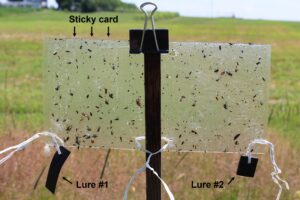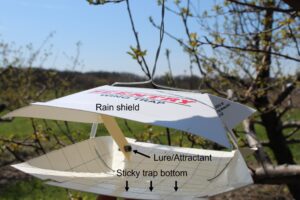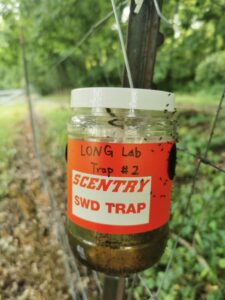Just a reminder to all fruit producers to organize and prep your fruit insect monitoring tools for the upcoming season! Depending on your fruit crop and location in the state, there’s a suite of fruit insects that are important for you to track, including moths, aphids, scales, stink bugs, fruit and vinegar flies, and beetles. Insect monitoring tools are so important because 1) they serve as an early detection tool, giving you an idea of when insects first appear relative to the vulnerable period for your fruit crop, and 2) they eliminate the need for you to “chase” insects: instead the lures, which mimic the attractive odor of fruit, female insects, or even both, do the work for you by drawing insects directly to a trap where they are captured, killed, and remain for you to see and track over the season. Anyone who checks the trap will see if target insects are present, and once you see them, you’ll be able to make an informed decision about the timing of action to protect your crop.
A few examples of common, important insects you’ll want to monitor this season include:
Codling moth – monitoring efforts are focused on detecting adult moths that are attracted to lures placed inside a “wing trap” with a sticky card on the bottom (Figure 1); however, it’s the caterpillar that is the damaging life stage. This pest prefers apples but may also attack other tree fruits.
Brown marmorated stink bug (BMSB) – monitoring efforts are focused on detecting adult stink bugs that are attracted to lures that are hung on a sticky trap (Figure 2); however, both adults and nymphs feed on fruit and can cause damage. This pest attacks a wide range of both fruit and vegetable crops, and will attack apples, peaches, and grapes to name a few.

Figure 2. Example of a dual-lure sticky panel monitoring trap for brown marmorated stink bug. Photo: E. Y. Long
Spotted-wing Drosophila (SWD) – monitoring efforts are focused on detecting adult flies that are attracted to a salt-and-vinegar scented pouch that is placed inside a peanut butter-like container with red coloring and soapy liquid at the bottom (Figure 3). Adult flies enter the container and then fall into the liquid and drown. This pest attacks small fruits, including raspberries, blackberries, blueberries, and grapes.
To further enhance your awareness of insect pest activity and their progress through the life cycle, you can track degree days to predict how quickly insects are developing, based on daily high and low temperatures. Because insect development is temperature dependent, progress from one life stage to the next (for example, the egg stage to the caterpillar stage) may speed up or slow down depending on daily temperatures.
Last, but not least, remember that preparing your monitor tools and placing them appropriately in your orchard is just the first step! It is critically important that you check your monitoring traps regularly, as often as three times a week, depending on the insect pest you’re monitoring and the vulnerability of your fruit crop during the season. Taken together, the ultimate goal of using insect monitoring traps and degree days is to keep track of the start, peak, and end of insect activity (be it adult flight or egg hatch), so that you can properly time insecticide applications to target the damaging life stage of the insect pest. For more information about important insects in fruit tree crops in particular, visit: https://extension.entm.purdue.edu/publications/E-274/E-274.html
The Long Lab team will be monitoring fruit insect activity in a few places in Indiana, depending on the fruit crop, and we’ll be sharing timely updates on insect activity in traps at this website: https://extension.entm.purdue.edu/longlab/extension/#reports. New this year: We are also looking for collaborators to monitor brown marmorated stink bugs in tree fruit orchards, so if you’re interested, please reach out to me – we will provide monitoring supplies and training in return for your partnership reporting traps counts.
If you have questions about how to find, purchase, or use monitoring tools for insect pests in your fruit crops, please reach out! Here’s to a happy fruiting season!

